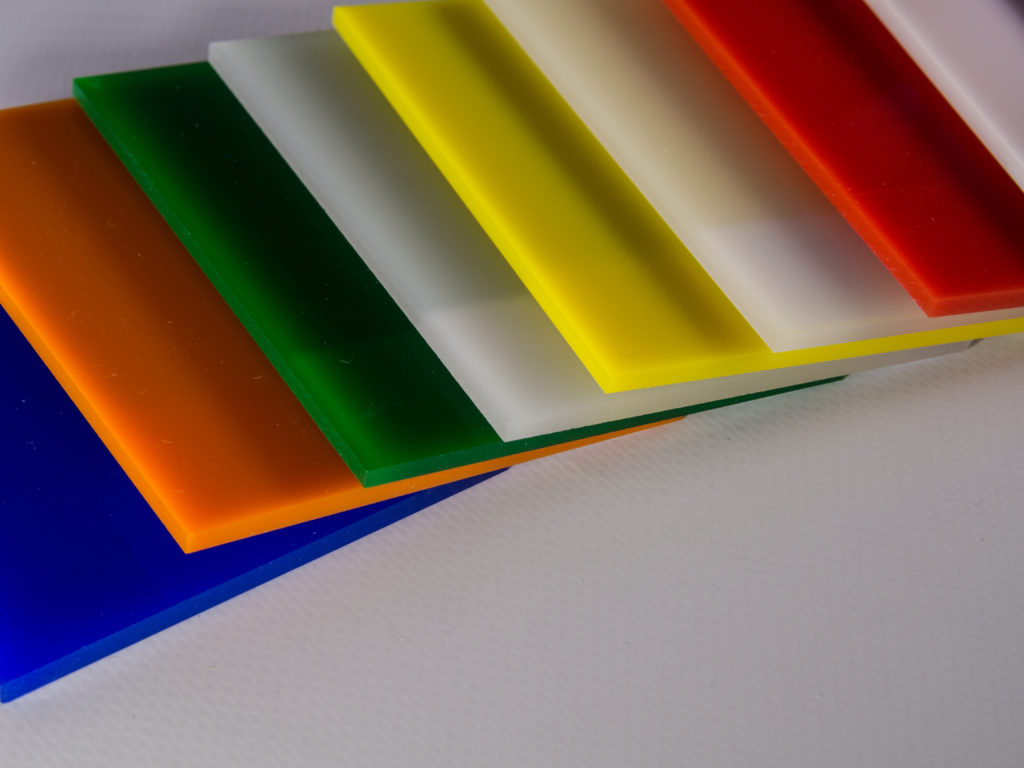When you think of acrylic, you probably picture a thin, clear sheet of plastic material. It is especially common in sneeze guards and protective coverings at businesses and healthcare facilities throughout the country since the onset of the COVID-19 pandemic. But acrylic is also popular in retail displays and decorative instances where a clear, strong piece of material is needed. The uses of colored acrylic are also very diverse for many decorative applications.

However, this versatile plastic material isn’t just available in its popular clear form. The uses of colored acrylic are very diverse in decorative applications. And it still offers all of the powerful attributes that make clear acrylic such a popular choice for many.
If you’re already familiar with the benefits of clear acrylic, then you may be interested in using more colored acrylic in your applications. Here’s a rundown of this material’s benefits, attributes, and potential uses.
About Colored Acrylic
Colored acrylic offers many of the same attributes as the clear acrylic that you’re likely already familiar with. As a refresher, acrylic is a common name for Polymethyl Methacrylate or PMMA. It is a thermoplastic that can easily be machined, cut to size, and formed into a number of shapes. This makes it an incredibly versatile material that is a popular choice for use in a wide range of industries and products.
In addition to its visual clarity and easy machinability, Acrylic is also known for displaying good impact resistance. Though not quite as strong as polycarbonate, acrylic is significantly more impact resistant than glass. The exact strength varies depending on the product you choose. But acrylic sheets are generally about 10 times more impact resistant than glass. So they are difficult to shatter when struck with a sharp or blunt object. This makes the material ideal for use in areas where they may be exposed to debris or moving components that could otherwise damage materials with less strength.
Basically, colored acrylic has all the same characteristics as clear acrylic, except for the appearance. Colored acrylic can come in translucent, tinted, or opaque forms. And since it’s created artificially, it’s available in a huge array of colors. Some of the most popular include blue, red, yellow, orange, gray, bronze, black, and white. There are various shades available within those color families as well. So if you have a specific look in mind, it’s almost certainly possible to find acrylic sheets that match your exact visual specifications. And depending on what type you choose, you may still enjoy some visual clarity, or the sheet may be fully opaque while still displaying the other physical characteristics of acrylic.
Uses of Colored Acrylic
In its clear form, acrylic sheets are popular in applications where it can take the place of glass. For example, transportation and construction companies may use them as operator protection in vehicles, since the material offers enough optical clarity for the driver to clearly see, without leaving them exposed. Acrylic sheets can also be used as skylights and windows in greenhouses and similar structures. In these applications, acrylic sheets allow enough light to pass through and still provide enough protection for the interior of these structures. Currently, clear acrylic is also incredibly popular in sneeze guards and countertop systems to provide easy protection and sanitization options for businesses and healthcare facilities.
Colored acrylic provides nearly all of the same powerful attributes as clear acrylic — except that optical clarity that is so important to many of the applications listed above. For that reason, the uses of colored acrylic are most commonly found in decorative applications. This may include things like signage, retail displays, furniture, kitchen backsplashes, and shelving or storage units. Some tinted versions may still be used in place of glass, especially in areas where you want only some light to pass through. For example, the top of a carport or greenhouse may require a durable material that allows some light transmission. But if you want a bit of glare protection and a unique visual look, tinted or colored acrylic may be the perfect solution.
Benefits of Colored Acrylic
Both clear and colored acrylic offer a wide array of high-performance properties. Outside of the visual elements of acrylic, the material is also known for providing low UV sensitivity and overall weather resistance, making it ideal for outdoor signage and similar applications. It is also slow to burn and can even be self-extinguishing in some instances. At the very least, it should not produce harmful smoke or gases when exposed to flame. This makes it a relatively safe material to use in a variety of environments.
It is also incredibly lightweight, which makes it easy to work with and install. Even if you’re working on DIY or decorative applications or don’t have a lot of experience or heavy equipment, acrylic is generally easy enough to carry around job sites and secure into various applications.
It is also easy to form and cut to size, which allows it to easily fit into a wide array of applications. You can order these products just how you need them so they’re ready to be installed or implemented right when you receive them. Coatings can even be applied to enhance the functionality of colored acrylic. A few examples include coatings for adding scratch-resistance, anti-fog, or reflective characteristics.
If you’re looking for colored acrylic to include in any of your upcoming projects, Polymershapes can help. We offer a huge array of texture and color options to suit the visual needs of each client. Our acrylic products come from trusted manufacturing partners, like Plaskolite, and we even offer additional value-added services like custom conversion and fabrication capabilities out of our local facilities. To browse colored acrylic options or speak with a team member who can help you find the ideal plastic materials for your applications, visit our website today.